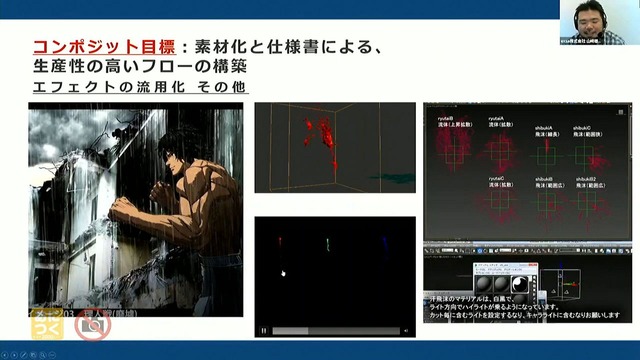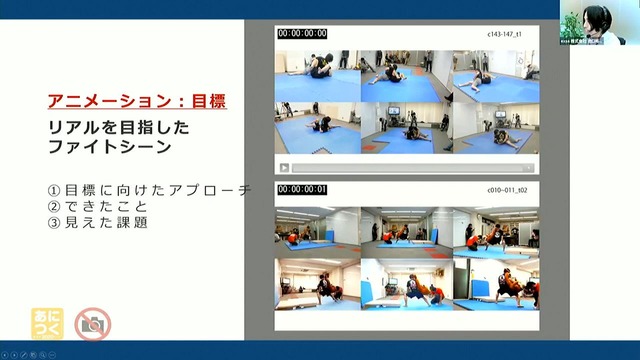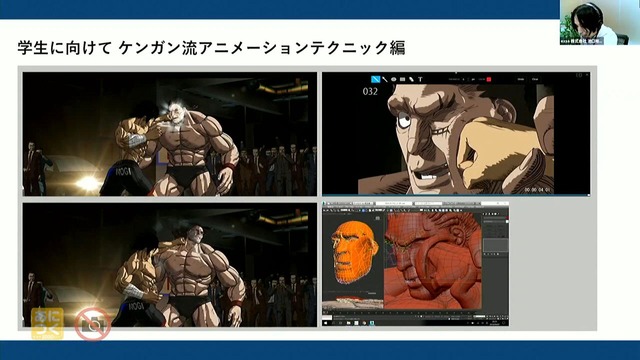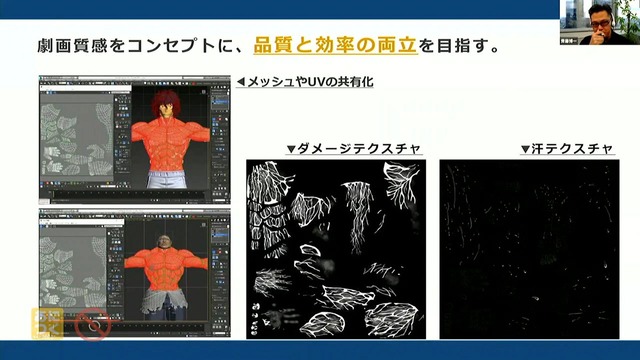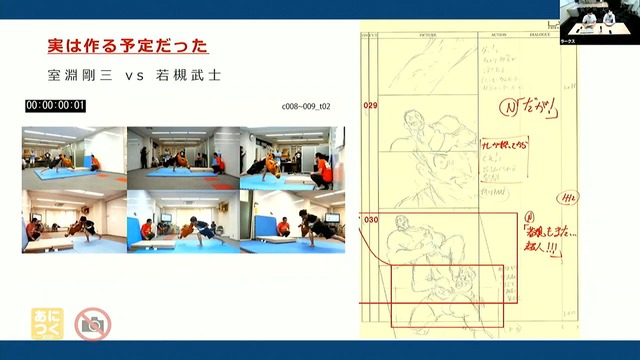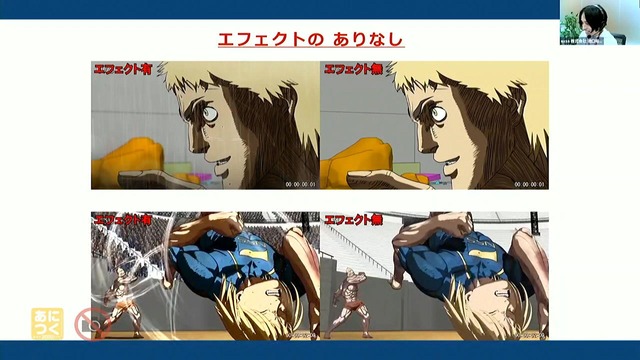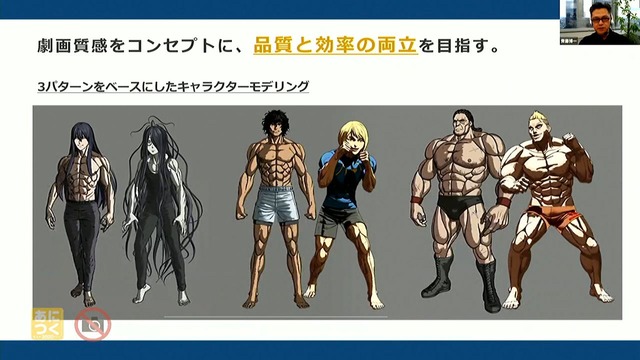“Anitsuku” has continued to hold various seminar events annually to educate the creators for anime production of the next generations.
This year, in 2020, the event changed to the live streaming, and was held from September 25 to 27, 2020 with the new title, “Anitsuku 2020 Online”.
“’Kengan Ashura’ CG Production Session”, in which the professionals discussed the background stories of “Kengan Ashura” (the original NETFLIX combat action anime) CG sections was held on the 3rd day, which was September 27.
Staffs from both LARX ENTERTAINMENT Co., Ltd., the studio in charge of animation production, and exsa Co., Ltd., which was in charge of CG section of “Kengan Ashura”, appeared on stage and mainly discussed the production process of CGs.
■ Why “Kengan Ashura” was produced with CGs?
Whom appeared on the stage were 5 members from 2 studios introduced above. Fukushima Ryouta (CG Director) and Nishiiri Hayao (CG Director) from LARX ENTERTAINMENT and Ikeguchi Yuuji (CG Producer), Saitou Hirokazu (Modeling Director), and Yamazaki Yuuta (Composite Director) from exsa appeared on the stage.
The first theme was “Why ‘Kengan Ashura’ was made with CGs?”.
CG director Fukushima opened his mouth first to respond.
The illustrations in the original manga are so dense and the fighting actions are drawn in the graphical taste, therefore producing it in 2D are too heavy. So, to deal with finance and schedule problems, the anime was produced with CG.
CG models can keep the certain quality levels of the illustrations and can decrease the work hours to design backgrounds and other parts.
■ Seeking for both high quality and efficiency, while reproducing the texture of realistic manga
The characters in the original manga have elaborated designs similar to dramatic mangas, including pointy shadows and silhouette that looks like nets, and they are creating the unique atmosphere of the manga itself.
The character concept art produced by LARX ENTERTAINMENT challenged to recreate the design of the original manga by having retouch to 3D model for reproduction.
As the result, the visual was accepted by the director, and the 3D model was used for the final version of the anime.
The next and the final character model was produced in exsa by using the concept art completed by LARX.
This process had to care about financial issue, while the concept art did not care about it. The staff struggled to resolve the various issues, including avoiding the troublesome chore and all issues related to “movement”.
What they struggled the most was the brush texture that could be seen in net-like shadows.
Each character should have fixed width in net shadow in any scene that they are appearing. However, the material called texture, which pastes shadows and other effects on a character, was forced to change its shape and size while the characters making movements.
That issue only could be solved by taking time to modify, and left as the future goals to solve for next generations.
The methods taken to cost compression and to increase efficiency were the following.
First, the character body models were made in 3 patterns: thin type, muscular type, and super muscular type.
While decreasing UV process that takes the longest hours of production, “net shadows”, textures for damage, and sweat texture now could be used for any character of any body type.
UV is the coordinate in 3D modeling. When creating 3-dimensional object with 3DCG, there are scenes, in which the work cannot be continued with 3D. The solution is to make 3DCG into 2-dimensional like an papercraft before starting. This is very troublesome process.
To resolve the issue, they used common UV and textures so that they can be shared through the studio.
Moreover, they produced materials called “texture”, so that they can just paste damages and net shadows in each scene.
Small steps to reduce work process lead to cost and work hour cuts, and finally produced the difference between the scenes that they should and should not work too hard, to create realistic anime with combat scenes.
■ Realistic combat scenes that learned from actual movements
Toward the combat scene production, the director thought that he wants to visualize the scenes that are not directly drawn between each block.
However, not all staff were familiar with actual combat techniques, therefore they do not have enough knowledge to fulfill the hidden scenes between each block. Then the studio invited approximately 10 people with actual combat experience.
The staff first attempted to use motion capture technology. However, the actions with devices were very difficult, so they shot the actions from 6 different directions to use them as reference materials.
They not only shot the actual movements, but the staffs in charge of illustration also actually experienced the combat practices to feel “atmosphere” of fighting between professional fighters.
By the way, the core members actually watched the professional wrestling games in the beginning of the project.
The staff not only felt the atmosphere and smacking sound of the fighter being floored down, they used it as the motivation to make the combat scenes as realistic as possible.
“Kengan Ashura” production side passionately discussed their strong commitment for the anime. However, they advised the students to make distinguishment between what they should care more, while finding scenes that they can reduce work, not putting full power to all scenes.
As a creator, it is true to hope to put full power to ALL scenes, even if it is a visual disappearing in a blink of an eye.
However, as professional members in work, they should also care about resources, time, and costs as well.
Even with a scene disappearing in a moment, if it is “an important scene with focus”, it should be produced with care. On the other hand, the scenes with less importance should not be produced with full resource.
Everything is about making distinguishments.
Based on whether the audience will know or not, they must think where to put limited resources. That is one “requirement” of the professional.
■ Increasing productivity by making common materials and specification documents
“Composite”, the process to combine multiple materials into one, is one of the final steps of the production. It gets effected severely with the schedule change, and does not have enough time to complete.
To increase efficiency and productivity, making the effects into asset so that any effect could be drawn out immediately for necessity.
For example, in the punching scene, to recreate intense rush of punches, the effect to describe the route of the knuckles was used. This effect is not only used for this scene and was used for other scenes to reduce task to make new ones for each necessity.
Another method to increase productivity was the creation of the specification document.
One person is usually in charge of composite process for each work. However, the staff participated and left more often than usual due to shortness of production period for “Kengan Ashura”. Therefore, to reduce time to explain what is going on, Yamazaki created the specification document to reduce extra task.
The goal of the specification document was “even a staff unfamiliar with the task will be able to get a work done at a certain quality with a quick look at the document”.
Although the document had numerous pages to read, but had certain positive effects.
“Kengan Ashura” expressed realistic scenes, while creating necessary atmosphere with multiple actions up till the end.
There were multiple challenges made behind the scenes to make it so real.
© 2019 Sandrovich Yabako. Daromeon, Shogakkan/Kengan Committee
[Anime! Anime! Biz/Article was taken from animeanime.biz]




